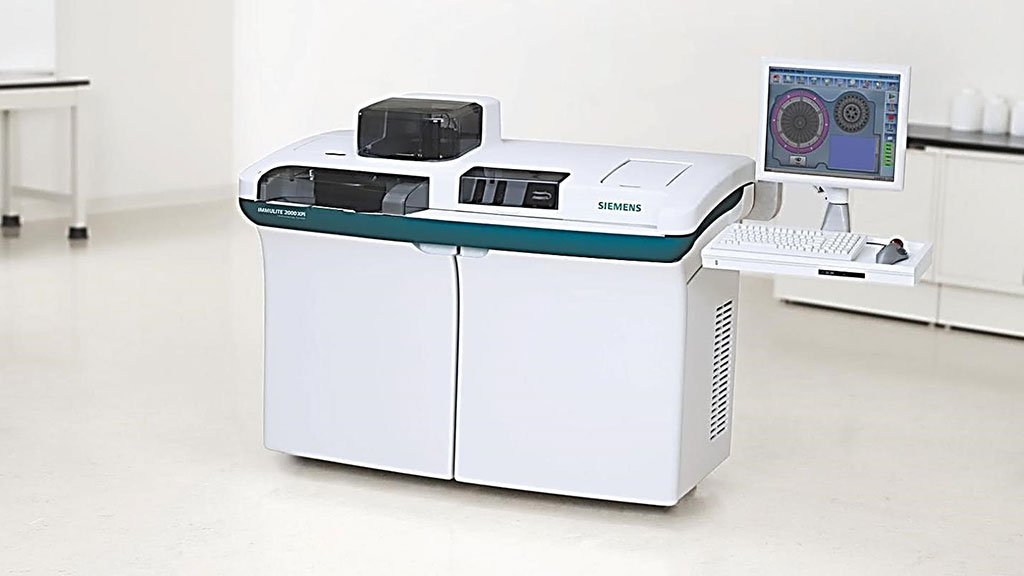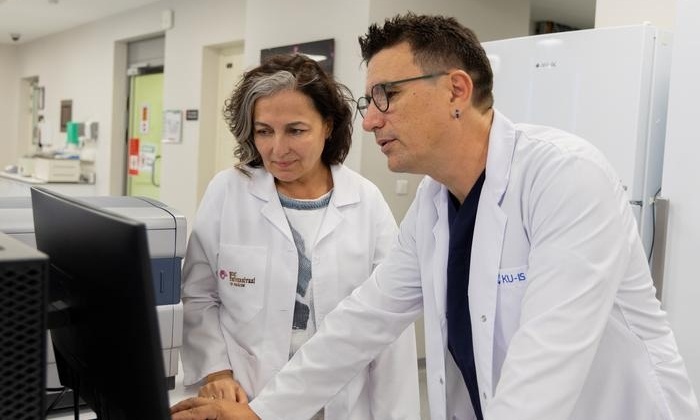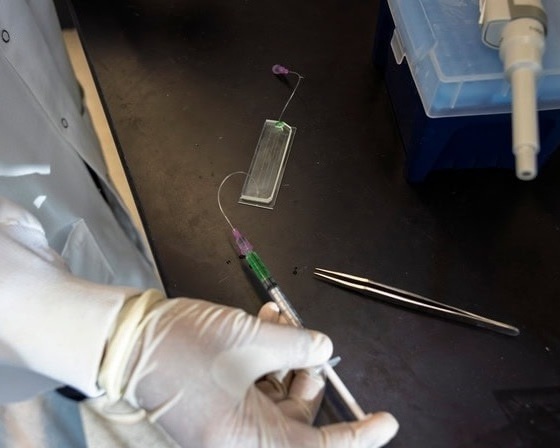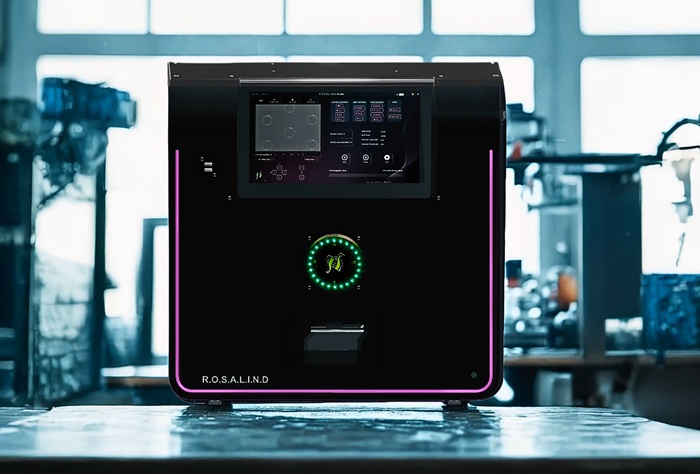Immunoassays Evaluated for Thyroid-Stimulating Receptor Antibody in Graves’ Disease
|
By LabMedica International staff writers Posted on 23 Nov 2021 |

Image: The IMMULITE 2000 XPi Immunoassay System provides multiple tests on a single, easy-to-use analyzer, including the thyroid-stimulating immunoglobulin assay (Photo courtesy of Siemens Healthcare)
Graves' disease (GD), also known as toxic diffuse goiter, is an autoimmune disease that affects the thyroid. It frequently results in and is the most common cause of hyperthyroidism and it also often results in an enlarged thyroid.
Thyroid-stimulating hormone (TSH) receptor (TSHR) autoantibodies (TRAbs) are pathognomonic of GD and are detected in the serum of approximately 98% of patients with untreated GD. The specific and sensitive detection of thyroid-stimulating immunoglobulin (TSI) from other types of TRAbs is becoming increasingly important for the diagnostic accuracy of the Graves’ hyperthyroidism and of the extrathyroidal manifestations of GD.
Medical Laboratorians at the Shanghai Medical College (Shanghai, China) and their colleagues recruited 559 patients in the period between October 2020 and February 2021. There were 166 GD patients, 81 patients of whom were untreated GD, 393 patients with other thyroid diseases including 79 patients with Hashimoto's thyroiditis, 103 patients with thyroid nodules, 96 patients with hypothyroidism, 59 patients with nontoxic goiter, and 56 patients with thyroid cyst. In addition, 20 euthyroid healthy subjects were recruited as normal controls.
The team evaluated the analytical and clinical performance of two immunoassays for diagnosis of Graves’ disease (GD): the Immulite thyroid-stimulating immunoglobulin (TSI, Siemens Healthcare, Erlangen, Germany), and the Elecsys Anti-TSH receptor (TSHR), assay (Roche Diagnostics, Mannheim, Germany). The Immulite TSI assay is a chemiluminescence immunoassay with the clinical decision point of 0.55 IU/L. The Roche Elecsys Anti-TSHR assay is a competitive assay using electrochemiluminescence detection.
The investigators reported that the repeatability and intermediate imprecision coefficient of variation (CV%) of the TSI assay were 3.8% and 4.1% at 0.95 IU/L, and 3.5% and 3.6% at 19.5 IU/L, respectively. The assays were linear over a range 0.27–38.5 IU/L. There was a high correlation between the quantitative results of the two methods. The cut-off value obtained by ROC analysis for TSI assay was 0.7 IU/L with sensitivity of 93.7% and specificity of 85.1%. An overall qualitative agreement of 91.5% between two methods was observed. Among 44 patients with discordant qualitative results, the TSI assay provided more satisfactory results consistent with clinical diagnoses.
The authors concluded that the Immulite TSI assay specifically measured the pathogenic antibody of GD and exhibited excellent analytical performance. The Immulite TSI assay may be of great value for the clinical diagnosis of GD. The study was published on November 11, 2021 in the Journal of Clinical Laboratory Analysis.
Related Links:
Shanghai Medical College
Siemens Healthcare
Roche Diagnostics
Thyroid-stimulating hormone (TSH) receptor (TSHR) autoantibodies (TRAbs) are pathognomonic of GD and are detected in the serum of approximately 98% of patients with untreated GD. The specific and sensitive detection of thyroid-stimulating immunoglobulin (TSI) from other types of TRAbs is becoming increasingly important for the diagnostic accuracy of the Graves’ hyperthyroidism and of the extrathyroidal manifestations of GD.
Medical Laboratorians at the Shanghai Medical College (Shanghai, China) and their colleagues recruited 559 patients in the period between October 2020 and February 2021. There were 166 GD patients, 81 patients of whom were untreated GD, 393 patients with other thyroid diseases including 79 patients with Hashimoto's thyroiditis, 103 patients with thyroid nodules, 96 patients with hypothyroidism, 59 patients with nontoxic goiter, and 56 patients with thyroid cyst. In addition, 20 euthyroid healthy subjects were recruited as normal controls.
The team evaluated the analytical and clinical performance of two immunoassays for diagnosis of Graves’ disease (GD): the Immulite thyroid-stimulating immunoglobulin (TSI, Siemens Healthcare, Erlangen, Germany), and the Elecsys Anti-TSH receptor (TSHR), assay (Roche Diagnostics, Mannheim, Germany). The Immulite TSI assay is a chemiluminescence immunoassay with the clinical decision point of 0.55 IU/L. The Roche Elecsys Anti-TSHR assay is a competitive assay using electrochemiluminescence detection.
The investigators reported that the repeatability and intermediate imprecision coefficient of variation (CV%) of the TSI assay were 3.8% and 4.1% at 0.95 IU/L, and 3.5% and 3.6% at 19.5 IU/L, respectively. The assays were linear over a range 0.27–38.5 IU/L. There was a high correlation between the quantitative results of the two methods. The cut-off value obtained by ROC analysis for TSI assay was 0.7 IU/L with sensitivity of 93.7% and specificity of 85.1%. An overall qualitative agreement of 91.5% between two methods was observed. Among 44 patients with discordant qualitative results, the TSI assay provided more satisfactory results consistent with clinical diagnoses.
The authors concluded that the Immulite TSI assay specifically measured the pathogenic antibody of GD and exhibited excellent analytical performance. The Immulite TSI assay may be of great value for the clinical diagnosis of GD. The study was published on November 11, 2021 in the Journal of Clinical Laboratory Analysis.
Related Links:
Shanghai Medical College
Siemens Healthcare
Roche Diagnostics
Latest Immunology News
- Blood Test Could Identify Colon Cancer Patients to Benefit from NSAIDs
- Blood Test Could Detect Adverse Immunotherapy Effects
- Routine Blood Test Can Predict Who Benefits Most from CAR T-Cell Therapy
- New Test Distinguishes Vaccine-Induced False Positives from Active HIV Infection
- Gene Signature Test Predicts Response to Key Breast Cancer Treatment
- Chip Captures Cancer Cells from Blood to Help Select Right Breast Cancer Treatment
- Blood-Based Liquid Biopsy Model Analyzes Immunotherapy Effectiveness
- Signature Genes Predict T-Cell Expansion in Cancer Immunotherapy
- Molecular Microscope Diagnostic System Assesses Lung Transplant Rejection
- Blood Test Tracks Treatment Resistance in High-Grade Serous Ovarian Cancer
- Luminescent Probe Measures Immune Cell Activity in Real Time
- Blood-Based Immune Cell Signatures Could Guide Treatment Decisions for Critically Ill Patients
- Novel Tool Predicts Most Effective Multiple Sclerosis Medication for Patients
- Companion Diagnostic Test for CRC Patients Identifies Eligible Treatment Population
- Novel Tool Uses Deep Learning for Precision Cancer Therapy
- Companion Diagnostic Test Identifies HER2-Ultralow Breast Cancer and Biliary Tract Cancer Patients
Channels
Clinical Chemistry
view channel
Noninvasive Blood-Glucose Monitoring to Replace Finger Pricks for Diabetics
People with diabetes often need to measure their blood glucose multiple times a day, most commonly through finger-prick blood tests or implanted sensors. These methods can be painful, inconvenient, and... Read more
POC Breath Diagnostic System to Detect Pneumonia-Causing Pathogens
Pseudomonas aeruginosa is a major cause of hospital-acquired and ventilator-associated pneumonia, particularly in lung transplant recipients and patients with structural lung disease. Its ability to form... Read moreMolecular Diagnostics
view channel
World's First NGS-Based Diagnostic Platform Fully Automates Sample-To-Result Process Within Single Device
Rapid point-of-need diagnostics are of critical need, especially in the areas of infectious disease and cancer testing and monitoring. Now, a direct-from-specimen platform that performs genomic analysis... Read more
Rapid Diagnostic Breakthrough Simultaneously Detects Resistance and Virulence in Klebsiella Pneumoniae
Antibiotic resistance is a steadily escalating threat to global healthcare, making common infections harder to treat and increasing the risk of severe complications. One of the most concerning pathogens... Read moreHematology
view channel
MRD Tests Could Predict Survival in Leukemia Patients
Acute myeloid leukemia is an aggressive blood cancer that disrupts normal blood cell production and often relapses even after intensive treatment. Clinicians currently lack early, reliable markers to predict... Read more
Platelet Activity Blood Test in Middle Age Could Identify Early Alzheimer’s Risk
Early detection of Alzheimer’s disease remains one of the biggest unmet needs in neurology, particularly because the biological changes underlying the disorder begin decades before memory symptoms appear.... Read more
Microvesicles Measurement Could Detect Vascular Injury in Sickle Cell Disease Patients
Assessing disease severity in sickle cell disease (SCD) remains challenging, especially when trying to predict hemolysis, vascular injury, and risk of complications such as vaso-occlusive crises.... Read more
ADLM’s New Coagulation Testing Guidance to Improve Care for Patients on Blood Thinners
Direct oral anticoagulants (DOACs) are one of the most common types of blood thinners. Patients take them to prevent a host of complications that could arise from blood clotting, including stroke, deep... Read moreMicrobiology
view channel
New UTI Diagnosis Method Delivers Antibiotic Resistance Results 24 Hours Earlier
Urinary tract infections affect around 152 million people every year, making them one of the most common bacterial infections worldwide. In routine medical practice, diagnosis often relies on rapid urine... Read more
Breakthroughs in Microbial Analysis to Enhance Disease Prediction
Microorganisms shape human health, ecosystems, and the planet’s climate, yet identifying them and understanding how they are related remains a major scientific challenge. Even with modern DNA sequencing,... Read morePathology
view channel
AI Tool Simultaneously Identifies Genetic Mutations and Disease Type
Interpreting genetic test results remains a major challenge in modern medicine, particularly for rare and complex diseases. While existing tools can indicate whether a genetic mutation is harmful, they... Read more
Rapid Low-Cost Tests Can Prevent Child Deaths from Contaminated Medicinal Syrups
Medicinal syrups contaminated with toxic chemicals have caused the deaths of hundreds of children worldwide, exposing a critical gap in how these products are tested before reaching patients.... Read more
Tumor Signals in Saliva and Blood Enable Non-Invasive Monitoring of Head and Neck Cancer
Head and neck cancers are among the most aggressive malignancies worldwide, with nearly 900,000 new cases diagnosed each year. Monitoring these cancers for recurrence or relapse typically relies on tissue... Read moreTechnology
view channel
Diagnostic Chip Monitors Chemotherapy Effectiveness for Brain Cancer
Glioblastoma is one of the most aggressive and fatal brain cancers, with most patients surviving less than two years after diagnosis. Treatment is particularly challenging because the tumor infiltrates... Read more
Machine Learning Models Diagnose ALS Earlier Through Blood Biomarkers
Amyotrophic lateral sclerosis (ALS) is a rapidly progressive neurodegenerative disease that is notoriously difficult to diagnose in its early stages. Early symptoms often overlap with other neurological... Read moreIndustry
view channel
BD and Penn Institute Collaborate to Advance Immunotherapy through Flow Cytometry
BD (Becton, Dickinson and Company, Franklin Lakes, NJ, USA) has entered into a strategic collaboration with the Institute for Immunology and Immune Health (I3H, Philadelphia, PA, USA) at the University... Read more







 assay.jpg)














